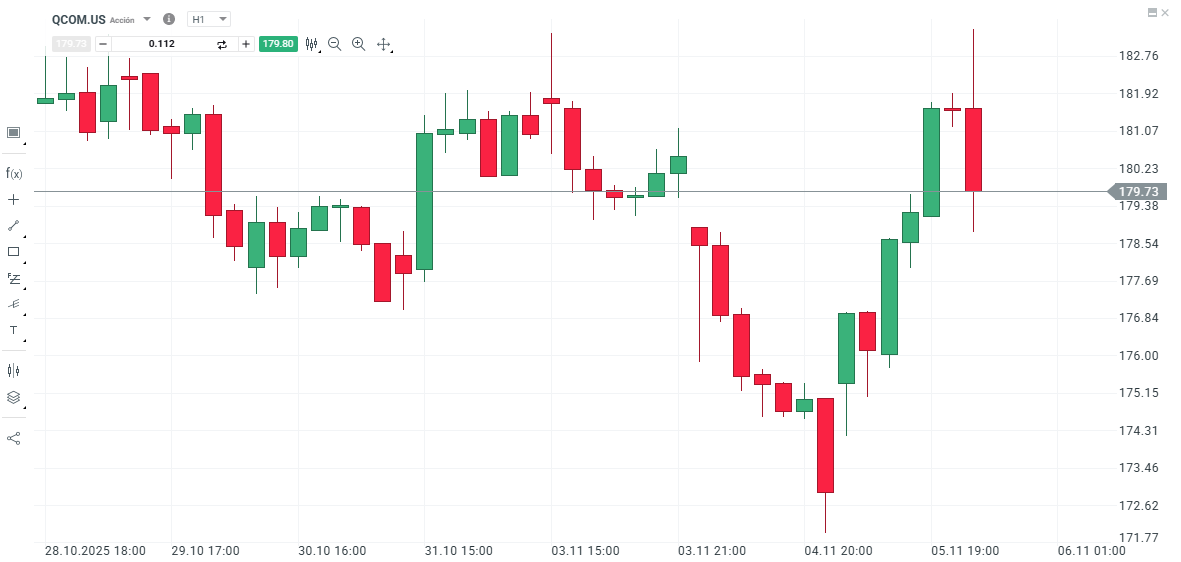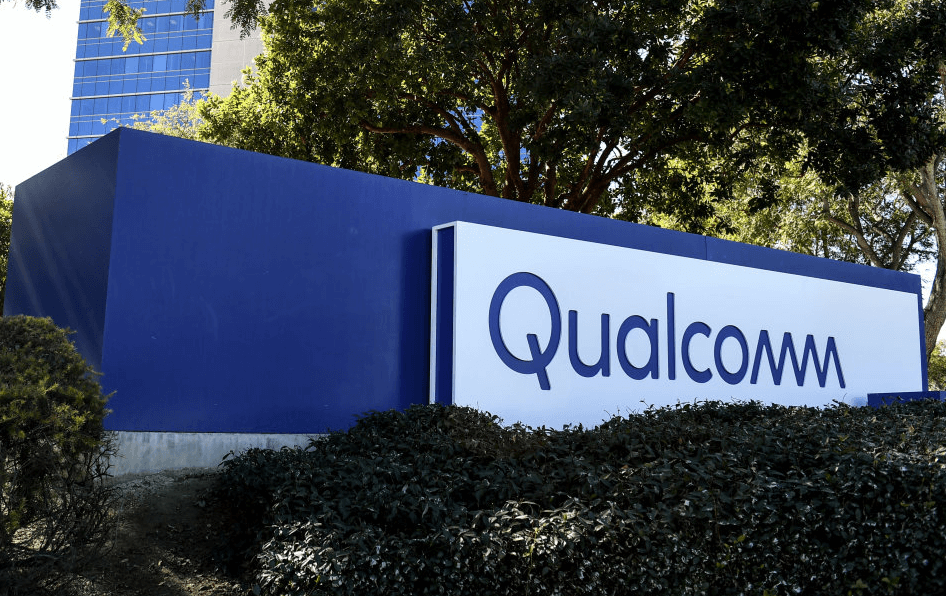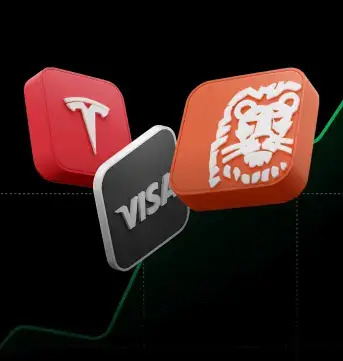- Qualcomm increases its revenue
- Are Qualcomm's results good?
- Qualcomm increases its revenue
- Are Qualcomm's results good?
Qualcomm reported a stronger-than-expected close to fiscal 2025, beating consensus across all key metrics and offering an upbeat forecast for its next quarter. Yet, despite the robust operational performance, shares slipped around 2.3% in after-hours trading as investors digested a one-time U.S. tax hit and questioned whether the company’s recent rally had run ahead of fundamentals.
Financial Performance Overview
-
Adjusted revenue: $11.27 billion, up 10% year-over-year (consensus: $10.77 billion)
-
Adjusted EPS: $3.00 per share, up from $2.69 a year ago (consensus: $2.88)
-
Adjusted operating income: $3.81 billion, +8.6% y/y (consensus: $3.65 billion)
-
QCT (chip segment) revenue: $9.82 billion, +13% y/y (consensus: $9.35 billion)
-
QTL (licensing) revenue: $1.41 billion, -7.4% y/y (consensus: $1.36 billion)
Growth was primarily driven by the handset division, which delivered $6.96 billion in revenue (+14%), reflecting strong Android and flagship device launches. The automotive business rose 17% to $1.05 billion, while the IoT segment expanded by 7.4% to $1.81 billion.
Full-year results also revealed 18% growth in QCT non-Apple revenues and 27% growth in combined automotive and IoT sales—key proof points for Qualcomm’s strategic diversification beyond smartphones.
Forecast and Tax Impact
For fiscal Q1 2026, Qualcomm guided:
-
Revenue: $11.8 billion – $12.6 billion (consensus: $11.59 billion)
-
Adjusted EPS: $3.30 – $3.50 (consensus: $3.26)
-
QCT revenue: $10.3 billion – $10.9 billion (consensus: $10.1 billion)
-
QTL revenue: $1.4 billion – $1.6 billion
Despite the optimistic revenue and profit outlook, Qualcomm booked a $5.7 billion writedown linked to a U.S. tax law adjustment, resulting in a net loss of $3.12 billion for the quarter. The company expects that adopting the Alternative Minimum Tax (AMT) framework will stabilize its long-term effective tax rate around 13–14%, below what it would have faced otherwise.
Business Momentum and Strategic Focus
CEO Cristiano Amon emphasized Qualcomm’s ongoing transformation into a diversified semiconductor player, citing strong traction in automotive chips, IoT growth, and new momentum in AI and PC processors.
The firm recently unveiled its AI 100 Ultra platform and next-generation Snapdragon chips, aiming to expand AI computing into data centers and personal devices. The company's first major data center AI chip is scheduled for 2026 shipments, with Humain, a Saudi-backed AI startup, as the launch customer.
Amon also reaffirmed optimism over Qualcomm’s automated driving stack and new design wins in connected vehicles — two long-term growth catalysts meant to buffer the gradual loss of Apple’s modem business as the iPhone maker transitions to internal components.
Competitive Landscape and Macro Context
Qualcomm remains deeply tied to mobile devices, but its diversification into automotive, IoT, and AI computing is gradually balancing the cyclical handset exposure. The competitive environment is shifting, particularly with Apple designing its own modems and rival MediaTek pushing into premium-tier Android devices.
The company also stands to gain from a geopolitical thaw after President Donald Trump and President Xi Jinping agreed to terminate antitrust investigations—potentially reducing regulatory and supply-chain pressure on U.S.–China chip trade.
Conclusions
The quarter is “solid upside,” citing across-the-board beats and an improving product mix. However, operating margins were slightly lighter than expected, and the market’s tepid reaction reflects inflated expectations after a pre-earnings stock run-up.
From a strategic perspective, Qualcomm’s quarter shows the company successfully navigating transition. Operationally, the core chip business continues to outperform peers in both consumer and industrial segments. The tax adjustment masks what was otherwise a structurally strong quarter, confirming execution strength under difficult macro and competitive conditions.
However, investor expectations have become difficult to meet in the current semiconductor rally. Much as seen with AMD and Micron, markets now demand demonstrable AI-driven profit acceleration, not just incremental improvement. Qualcomm’s deep consumer orientation and more modest AI exposure may have limited excitement relative to firms like Nvidia or Arm.
That said, the pathway toward diversification — through automotive, edge AI, and PC markets — remains intact and credible. The next 12–18 months will test Qualcomm’s ability to capitalize on this positioning, particularly as it launches AI PC chips set to rival Apple’s M-series and AMD’s new AI-accelerated lines.
 Source: xStation5
Source: xStation5
Rheinmetall after Earnings: Investors welcome soaring sales and investments
Deutsche Boerse down 5% amid European Commission antitrust investigation🚩
Morning wrap (06.11.2025)
US OPEN: Is This the Turning Point After the Correction?
The content of this report has been created by XTB S.A., with its registered office in Warsaw, at Prosta 67, 00-838 Warsaw, Poland, (KRS number 0000217580) and supervised by Polish Supervision Authority ( No. DDM-M-4021-57-1/2005). This material is a marketing communication within the meaning of Art. 24 (3) of Directive 2014/65/EU of the European Parliament and of the Council of 15 May 2014 on markets in financial instruments and amending Directive 2002/92/EC and Directive 2011/61/EU (MiFID II). Marketing communication is not an investment recommendation or information recommending or suggesting an investment strategy within the meaning of Regulation (EU) No 596/2014 of the European Parliament and of the Council of 16 April 2014 on market abuse (market abuse regulation) and repealing Directive 2003/6/EC of the European Parliament and of the Council and Commission Directives 2003/124/EC, 2003/125/EC and 2004/72/EC and Commission Delegated Regulation (EU) 2016/958 of 9 March 2016 supplementing Regulation (EU) No 596/2014 of the European Parliament and of the Council with regard to regulatory technical standards for the technical arrangements for objective presentation of investment recommendations or other information recommending or suggesting an investment strategy and for disclosure of particular interests or indications of conflicts of interest or any other advice, including in the area of investment advisory, within the meaning of the Trading in Financial Instruments Act of 29 July 2005 (i.e. Journal of Laws 2019, item 875, as amended). The marketing communication is prepared with the highest diligence, objectivity, presents the facts known to the author on the date of preparation and is devoid of any evaluation elements. The marketing communication is prepared without considering the client’s needs, his individual financial situation and does not present any investment strategy in any way. The marketing communication does not constitute an offer of sale, offering, subscription, invitation to purchase, advertisement or promotion of any financial instruments. XTB S.A. is not liable for any client’s actions or omissions, in particular for the acquisition or disposal of financial instruments, undertaken on the basis of the information contained in this marketing communication. In the event that the marketing communication contains any information about any results regarding the financial instruments indicated therein, these do not constitute any guarantee or forecast regarding the future results.


